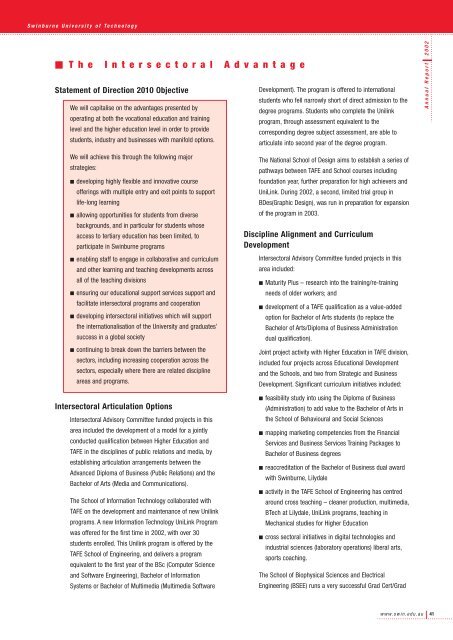Annual Report - Swinburne University of Technology
Annual Report - Swinburne University of Technology
Annual Report - Swinburne University of Technology
You also want an ePaper? Increase the reach of your titles
YUMPU automatically turns print PDFs into web optimized ePapers that Google loves.
<strong>Swinburne</strong> <strong>University</strong> <strong>of</strong> <strong>Technology</strong><br />
■ The Intersectoral Advantage<br />
Statement <strong>of</strong> Direction 2010 Objective<br />
Development). The program is <strong>of</strong>fered to international<br />
students who fell narrowly short <strong>of</strong> direct admission to the<br />
We will capitalise on the advantages presented by<br />
degree programs. Students who complete the Unilink<br />
operating at both the vocational education and training<br />
program, through assessment equivalent to the<br />
level and the higher education level in order to provide<br />
corresponding degree subject assessment, are able to<br />
students, industry and businesses with manifold options.<br />
articulate into second year <strong>of</strong> the degree program.<br />
<strong>Annual</strong> <strong>Report</strong> 2002<br />
We will achieve this through the following major<br />
strategies:<br />
■ developing highly flexible and innovative course<br />
<strong>of</strong>ferings with multiple entry and exit points to support<br />
life-long learning<br />
■ allowing opportunities for students from diverse<br />
backgrounds, and in particular for students whose<br />
access to tertiary education has been limited, to<br />
participate in <strong>Swinburne</strong> programs<br />
■ enabling staff to engage in collaborative and curriculum<br />
and other learning and teaching developments across<br />
all <strong>of</strong> the teaching divisions<br />
■ ensuring our educational support services support and<br />
facilitate intersectoral programs and cooperation<br />
■ developing intersectoral initiatives which will support<br />
the internationalisation <strong>of</strong> the <strong>University</strong> and graduates’<br />
success in a global society<br />
■ continuing to break down the barriers between the<br />
sectors, including increasing cooperation across the<br />
sectors, especially where there are related discipline<br />
areas and programs.<br />
Intersectoral Articulation Options<br />
Intersectoral Advisory Committee funded projects in this<br />
area included the development <strong>of</strong> a model for a jointly<br />
conducted qualification between Higher Education and<br />
TAFE in the disciplines <strong>of</strong> public relations and media, by<br />
establishing articulation arrangements between the<br />
Advanced Diploma <strong>of</strong> Business (Public Relations) and the<br />
Bachelor <strong>of</strong> Arts (Media and Communications).<br />
The School <strong>of</strong> Information <strong>Technology</strong> collaborated with<br />
TAFE on the development and maintenance <strong>of</strong> new Unilink<br />
programs. A new Information <strong>Technology</strong> UniLink Program<br />
was <strong>of</strong>fered for the first time in 2002, with over 30<br />
students enrolled. This Unilink program is <strong>of</strong>fered by the<br />
TAFE School <strong>of</strong> Engineering, and delivers a program<br />
equivalent to the first year <strong>of</strong> the BSc (Computer Science<br />
and S<strong>of</strong>tware Engineering), Bachelor <strong>of</strong> Information<br />
Systems or Bachelor <strong>of</strong> Multimedia (Multimedia S<strong>of</strong>tware<br />
The National School <strong>of</strong> Design aims to establish a series <strong>of</strong><br />
pathways between TAFE and School courses including<br />
foundation year, further preparation for high achievers and<br />
UniLink. During 2002, a second, limited trial group in<br />
BDes(Graphic Design), was run in preparation for expansion<br />
<strong>of</strong> the program in 2003.<br />
Discipline Alignment and Curriculum<br />
Development<br />
Intersectoral Advisory Committee funded projects in this<br />
area included:<br />
■ Maturity Plus – research into the training/re-training<br />
needs <strong>of</strong> older workers; and<br />
■ development <strong>of</strong> a TAFE qualification as a value-added<br />
option for Bachelor <strong>of</strong> Arts students (to replace the<br />
Bachelor <strong>of</strong> Arts/Diploma <strong>of</strong> Business Administration<br />
dual qualification).<br />
Joint project activity with Higher Education in TAFE division,<br />
included four projects across Educational Development<br />
and the Schools, and two from Strategic and Business<br />
Development. Significant curriculum initiatives included:<br />
■ feasibility study into using the Diploma <strong>of</strong> Business<br />
(Administration) to add value to the Bachelor <strong>of</strong> Arts in<br />
the School <strong>of</strong> Behavioural and Social Sciences<br />
■ mapping marketing competencies from the Financial<br />
Services and Business Services Training Packages to<br />
Bachelor <strong>of</strong> Business degrees<br />
■ reaccreditation <strong>of</strong> the Bachelor <strong>of</strong> Business dual award<br />
with <strong>Swinburne</strong>, Lilydale<br />
■ activity in the TAFE School <strong>of</strong> Engineering has centred<br />
around cross teaching – cleaner production, multimedia,<br />
BTech at Lilydale, UniLink programs, teaching in<br />
Mechanical studies for Higher Education<br />
■ cross sectoral initiatives in digital technologies and<br />
industrial sciences (laboratory operations) liberal arts,<br />
sports coaching.<br />
The School <strong>of</strong> Biophysical Sciences and Electrical<br />
Engineering (BSEE) runs a very successful Grad Cert/Grad<br />
www.swin.edu.au<br />
41

















